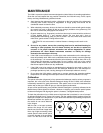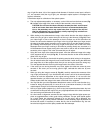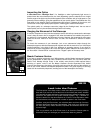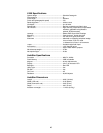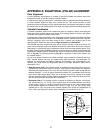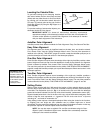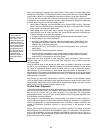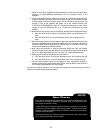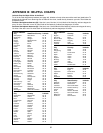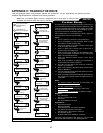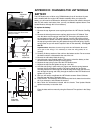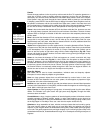
51
1.
Obtain a rough polar alignment as described earlier. Place the illuminated reticle
eyepiece (or eyepiece/Barlow combination) into the eyepiece holder of the
telescope.
2. Point the telescope, with the motor drive running, at a moderately bright star near
where the meridian (the North-South line passing through your local zenith) and the
celestial equator intersect. For best results, the star should be located within ±30
minutes in R.A. of the meridian and within ±5° of the celestial equator (see
“CELESTIAL COORDINATES,” page 47). Pointing the telescope at a star that is
straight up, with the Declination set to 0°, will point the telescope in the right
direction.
3. Note the extent of the star’s drift in Declination (disregard drift in Right Ascension):
a.
If the star drifts South (or down), the telescope’s polar axis is pointing too far
East.
b. If the star drifts North (or up), the telescope’s polar axis is pointing too far
West.
4. Move the wedge in azimuth (horizontally) to effect the appropriate change in polar
alignment. Reposition the telescope’s East-West polar axis orientation until there is
no further North-South drift by the star. Track the star for a period of time to be
certain that its Declination drift has ceased.
5. Next, point the telescope at another moderately bright star near the Eastern
horizon, but still near the celestial equator.For best results, the star should be about
20° or 30° above the Eastern horizon and within ± 5° of the celestial equator.
6. Again note the extent of the star’s drift in Declination:
a. If the star drifts South, (or down) the telescope’s polar axis is pointing too low.
b. If the star drifts North, (or up) the telescope’s polar axis is pointing too high.
7. Use the altitude adjust control on the wedge to make appropriate changes in
altitude, based on your observations above.Again, track the star for a period of time
to be certain that Declination drift has ceased.
The above procedure results in very accurate polar alignment, and minimizes the need for
tracking corrections during astrophotography.
LX90 TIPS
Star Charts
Even with the Autostar 30,000 object library, star charts and planispheres are
still useful f
or a v
ar
iety of reasons
.
In par
ticular
, the
y are a great aid in plan-
ning a night of celestial vie
wing.
A wide variety of star charts are available in books, in magazines, on the inter-
net and on CD Roms
.
Meade off
ers Epoch 2000sk
™
and other star locator
softw
are
. Contact your Meade dealer or Meade's Customer Service depart-
ment for more information.
Astronom
y
and Sky and
T
elescope
magazines pr
int star char
ts each month
for up-to-the-minute maps of the heavens.



